





Thanksgiving is at its heart a harvest festival. Make the holiday special by featuring the seasonal bounty of your own garden on the table at your Thanksgiving feast.
The Thanksgiving feast in the United States is a matter of cherished tradition. Families gather every year around the table to enjoy the dishes traditionally associated with this holiday. This year, I plan to celebrate the harvest festival by featuring the seasonal produce of my own garden for Thanksgiving dinner.
There is a reason for most of the dishes that have become traditional at this holiday. Many of the foods most closely tied to Thanksgiving are the produce of the season, the foods that were always available and at their best at the end of November, fresh from the garden or stored in the cellar.
Most of us do not raise our own turkeys, or live where wild turkeys can be hunted. But we do have our gardens where we can raise some of the traditional seasonal crops that are a cherished part of the Thanksgiving feast.
Potatoes
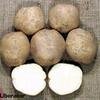 Of all the dishes on the Thanksgiving table, one of the most important in many families is the big bowl of mashed potatoes, calling out for turkey gravy. Potatoes are easy to grow in much of the country, and they yield a big crop for the space the plants take up in the garden. They also keep well in storage, so that potatoes harvested in early fall should still be ready in the cellar to face the potato masher by the time the turkey is in the oven. Ricing the cooked potatoes is a good way to make sure they are lump-free. Adventurous cooks might consider adding mashed onions or garlic, even mashed parsnips, if they are sure the traditionalists won't object.
Of all the dishes on the Thanksgiving table, one of the most important in many families is the big bowl of mashed potatoes, calling out for turkey gravy. Potatoes are easy to grow in much of the country, and they yield a big crop for the space the plants take up in the garden. They also keep well in storage, so that potatoes harvested in early fall should still be ready in the cellar to face the potato masher by the time the turkey is in the oven. Ricing the cooked potatoes is a good way to make sure they are lump-free. Adventurous cooks might consider adding mashed onions or garlic, even mashed parsnips, if they are sure the traditionalists won't object.
Sweet Potatoes
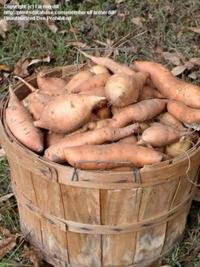
The long growing season for this tender crop means that it is grown in the warmer parts of the U.S. and harvested before the first frost, making it one of the most popular foods on the Thanksgiving table. For many families, the holiday wouldn't be Thanksgiving without sweet potatoes. They are a versatile vegetable that can be mashed, baked, or roasted. They can be simmered or braised with syrup to make "candied yams." * And they can be baked into a pie for a traditional dessert.
Winter Squash
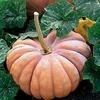 Squash is another tender vegetable that has to be harvested before a freeze, but winter squashes keep quite well in storage and even improve in flavor while down in the cellar. My own favorite is a puree of butternut squash, seasoned with mace and a bit of brown sugar. Acorn or other ribbed squash can be sliced, roasted, and finished with a glaze. And many Thanksgiving meals begin with a tureen full of savory squash soup.
Squash is another tender vegetable that has to be harvested before a freeze, but winter squashes keep quite well in storage and even improve in flavor while down in the cellar. My own favorite is a puree of butternut squash, seasoned with mace and a bit of brown sugar. Acorn or other ribbed squash can be sliced, roasted, and finished with a glaze. And many Thanksgiving meals begin with a tureen full of savory squash soup.
Carrots
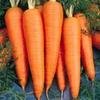 An orange vegetable less often found on the Thanksgiving table is the carrot, but this is a cold weather crop that can be harvested right out of the garden in most regions, just in time for the feast. A touch of frost only makes them sweeter. The "baby carrots" sold in stores are just large old roots chopped and trimmed by a machine; gardeners can go out and pick the real thing, fresh and tender. Carrots make an elegant dish braised and glazed with a sauce of butter and honey, and they can also be roasted, either alone or in combination with other winter vegetables.
An orange vegetable less often found on the Thanksgiving table is the carrot, but this is a cold weather crop that can be harvested right out of the garden in most regions, just in time for the feast. A touch of frost only makes them sweeter. The "baby carrots" sold in stores are just large old roots chopped and trimmed by a machine; gardeners can go out and pick the real thing, fresh and tender. Carrots make an elegant dish braised and glazed with a sauce of butter and honey, and they can also be roasted, either alone or in combination with other winter vegetables.
Brussels Sprouts
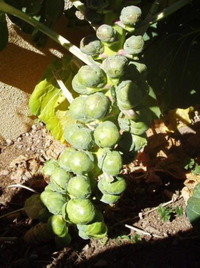 Most of the green vegetables found traditionally on the Thanksgiving table belong to the cole family, the many different varieties of the species Brassica oleracea. These plants are very hardy and thrive in colder weather. In some cases, as with Brussels sprouts, the flavor is improved by frost. For this reason, these little cabbage sprouts are usually harvested late in the season, just in time for the Thanksgiving feast. They can be cooked in a number of different ways: braised in stock or white wine; baked with buttered breadcrumbs; cooked in a casserole with onions, bay leaf, a bit of smoked ham and a splash of basalmic vinegar; or served with a Parmesan cheese sauce, browned under the broiler.
Most of the green vegetables found traditionally on the Thanksgiving table belong to the cole family, the many different varieties of the species Brassica oleracea. These plants are very hardy and thrive in colder weather. In some cases, as with Brussels sprouts, the flavor is improved by frost. For this reason, these little cabbage sprouts are usually harvested late in the season, just in time for the Thanksgiving feast. They can be cooked in a number of different ways: braised in stock or white wine; baked with buttered breadcrumbs; cooked in a casserole with onions, bay leaf, a bit of smoked ham and a splash of basalmic vinegar; or served with a Parmesan cheese sauce, browned under the broiler.
Broccoli
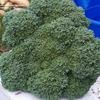 Many people consider the taste of Brussels sprouts too strong; broccoli can be a happy substitute. Like other members of this family, broccoli will be enhanced in flavor by November frosts. It is very easy to cook, requiring only to be steamed until tender. Broccoli should never be overcooked until the florets are mushy. If you serve both the heads and the stalks, cook them separately. Broccoli makes a simple but elegant holiday dish with a lemony Hollandaise sauce.
Many people consider the taste of Brussels sprouts too strong; broccoli can be a happy substitute. Like other members of this family, broccoli will be enhanced in flavor by November frosts. It is very easy to cook, requiring only to be steamed until tender. Broccoli should never be overcooked until the florets are mushy. If you serve both the heads and the stalks, cook them separately. Broccoli makes a simple but elegant holiday dish with a lemony Hollandaise sauce.
Cauliflower
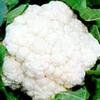 Cauliflower counts as a green vegetable even though its heads are usually blanched white. It is the least frost-hardy of all the cole crops and may not stand until late November in the more northerly growing zones, but it does prefer to ripen in cool weather. The contrast of the white heads with a bright yellow cheese sauce is attractive, but you can zip up the sauce by making it with a sharp Cheddar, beer, mustard and a bit of horseradish, as in the sauce for Welsh rarebit.
Cauliflower counts as a green vegetable even though its heads are usually blanched white. It is the least frost-hardy of all the cole crops and may not stand until late November in the more northerly growing zones, but it does prefer to ripen in cool weather. The contrast of the white heads with a bright yellow cheese sauce is attractive, but you can zip up the sauce by making it with a sharp Cheddar, beer, mustard and a bit of horseradish, as in the sauce for Welsh rarebit.
Spinach
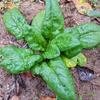 A cool season green vegetable that is not a member of the cole family. Spinach makes an excellent salad, and it is also a versatile cooked vegetable. Any dish with the name of "Florentine" will contain spinach. Unlike many other kinds of greens, it only needs a short cooking time. A gallon of fresh spinach leaves will cook down rapidly, so be sure to pick enough to go around. For many dishes, the cooked spinach should be very thoroughly drained, to the point of pressing out the liquid. Chopped spinach is delicious in a cream sauce flavored with Parmesan or Asiago cheese and a sprinkle of nutmeg.
A cool season green vegetable that is not a member of the cole family. Spinach makes an excellent salad, and it is also a versatile cooked vegetable. Any dish with the name of "Florentine" will contain spinach. Unlike many other kinds of greens, it only needs a short cooking time. A gallon of fresh spinach leaves will cook down rapidly, so be sure to pick enough to go around. For many dishes, the cooked spinach should be very thoroughly drained, to the point of pressing out the liquid. Chopped spinach is delicious in a cream sauce flavored with Parmesan or Asiago cheese and a sprinkle of nutmeg.
Parsnips
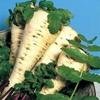 The parsnip is a hardy, cold-season root vegetable that, like the carrot, gets sweeter and more flavorful once it is touched by frost. In many areas, the roots are left in the ground all winter and dug up as needed. The affinity of parsnips for butter is well-attested. Parsnips and other root vegetables such as carrots, turnips and onions can be roasted together until caramelized for a special winter dish. Parsnips are often mashed, sometimes together with potatoes, and creamed parsnips are another nice serving possibility.
The parsnip is a hardy, cold-season root vegetable that, like the carrot, gets sweeter and more flavorful once it is touched by frost. In many areas, the roots are left in the ground all winter and dug up as needed. The affinity of parsnips for butter is well-attested. Parsnips and other root vegetables such as carrots, turnips and onions can be roasted together until caramelized for a special winter dish. Parsnips are often mashed, sometimes together with potatoes, and creamed parsnips are another nice serving possibility.
Leeks
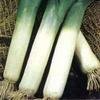 Like many members of the onion family, leeks are so cold-hardy that they are over-wintered in many areas. They can be used in just about any recipe that calls for onions, sweeter and milder, but they are also good as a dish on their own. Leeks are delicious roasted, caramelized or glazed. Braised leeks can be cooked with butter, turkey stock, or white wine. Creamed leeks make a colorful variation on creamed pearl onions, with the green of the leaves contrasting with the white of the lower stems. And a leek tart makes an elegant presentation on the holiday table.
Like many members of the onion family, leeks are so cold-hardy that they are over-wintered in many areas. They can be used in just about any recipe that calls for onions, sweeter and milder, but they are also good as a dish on their own. Leeks are delicious roasted, caramelized or glazed. Braised leeks can be cooked with butter, turkey stock, or white wine. Creamed leeks make a colorful variation on creamed pearl onions, with the green of the leaves contrasting with the white of the lower stems. And a leek tart makes an elegant presentation on the holiday table.
Pies
 In many households, Thanksgiving is not Thanksgiving without the right kind of pie, most often a pumpkin pie. It takes the right kind of pumpkin to make a pie. Pumpkins grown for jack-o-lanterns will be too stringy and watery. Varieties like 'Sugar Pie' and 'New England Pie' will yield excellent results, but many varieties of winter squash, particularly the Cushaw types, are also used for "pumpkin" pie. Another traditional Thanksgiving dessert is the sweet potato pie. On my own table, there will also be an apple pie, because I have a refrigerator full of apples harvested from my trees.
In many households, Thanksgiving is not Thanksgiving without the right kind of pie, most often a pumpkin pie. It takes the right kind of pumpkin to make a pie. Pumpkins grown for jack-o-lanterns will be too stringy and watery. Varieties like 'Sugar Pie' and 'New England Pie' will yield excellent results, but many varieties of winter squash, particularly the Cushaw types, are also used for "pumpkin" pie. Another traditional Thanksgiving dessert is the sweet potato pie. On my own table, there will also be an apple pie, because I have a refrigerator full of apples harvested from my trees.
In some warmer parts of the country, people plant fall gardens that are still producing at the end of November, even warm-weather crops like beans, peppers or eggplant. While some of these might not be traditional Thanksgiving foods, go ahead and celebrate the harvest by putting them on your holiday table. This is what a harvest festival is all about.
* This article has a discussion of the difference between sweet potatoes and yams.
Photo Credits: Brussels sprouts: pajaritomt
Pumpkin: LilyLover_UT
All the rest: Farmerdill
(Editor's Note: This article was originally published on November 19, 2008. Your comments are welcome, but please be aware that authors of previously published articles may not be able to promptly respond to new questions or comments.)
Copyright © www.100flowers.win Botanic Garden All Rights Reserved